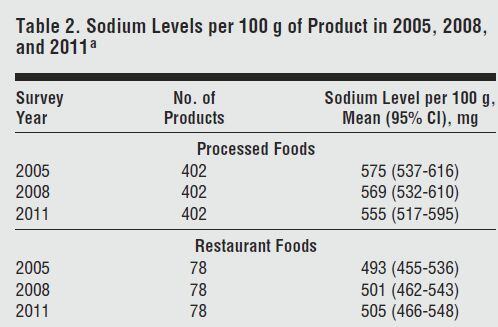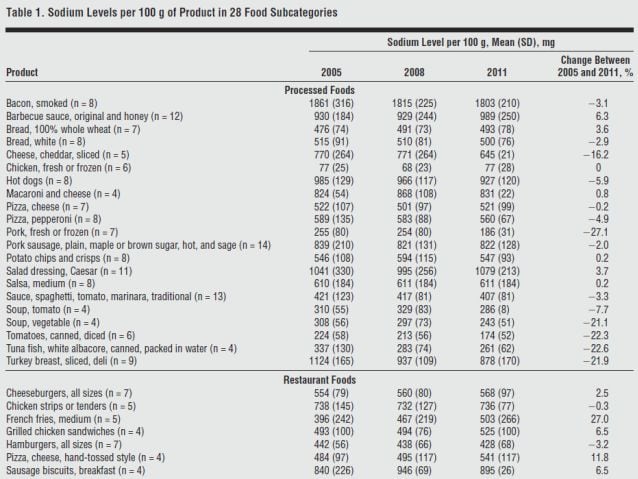The research - published in JAMA Internal Medicine (click here) - was conducted by Dr Michael Jacobson, executive director at the Center for Science in the Public Interest; Dr Stephen Havas, Professor of Preventive Medicine at Northwestern University Feinberg School of Medicine; and Dr Robert McCarter, Professor, Pediatrics, Epidemiology and Biostatistics at George Washington University School of Medicine.
Research consistent with NHANES data showing sodium intakes rose steadily between 2001 and 2010
Their analysis revealed significant reductions in some retail products over the six-year period (sliced cheddar cheese -16.2%, pork -27.1%, canned tomatoes -22.3%, canned tuna -22.6%, vegetable soup -21.1% and sliced (deli) Turkey breast -21.9%), but significant increases in some restaurant foods (cheese pizza +11.8%, breakfast sausage biscuits +6.5%, French fries +27%, grilled chicken sandwiches +6.5%).
Meanwhile, sodium levels in many retail product categories surveyed remained unchanged over the six-year period (chicken, salsa, potato chips, Mac & Cheese) or edged up slightly (BBQ sauce, whole wheat bread, salad dressing). See the complete chart below.
The findings are consistent with those of a recent analysis (click here) of National Health and Nutrition Examination Survey (NHANES) data, which showed that despite industry efforts, average sodium intakes rose steadily between 2001 and 2010, and at 3,559mg/day, are way above the maximum levels recommended in the Dietary Guidelines for Americans (2,300mg/day - or 1,500mg for at-risk groups).
The predominant finding, claim the authors, is "the absence of any appreciable or statistically significant changes in sodium content during six years".
While the study is not comprehensive, the products selected are weighted towards categories that contribute the most to population-wide sodium intakes, they add.
Some companies have made a lot of progress, but others have not made any progress
Speaking to FoodNavigator-USA about the JAMA data, co-author Dr Stephen Havas acknowledged that progress had been made, but said that the overall results showed that voluntary approaches were not working because not all manufacturers have bought into the process, and because the reductions they are making are not large enough.
“Yes, some companies have made a lot of progress, but others have not made any progress”, he said.
"In fact, some restaurant chains have largely ignored this issue."
In aggregate, he said, the data showed a modest 3.5% reduction in sodium in 402 processed foods, and a 2.6% increase in 78 products sold in fast-food restaurants, which is "distressing" given that a growing proportion of the food dollar is now spent on foods eaten outside the home.
Interestingly, the research also revealed large differences in sodium levels between market-leading products in the foodservice arena, with Burger King's medium fries containing 98% more sodium per 100g than McDonald's fries, but McDonald's Quarter Pounder with Cheese containing 34% more sodium than Burger King's Original Whopper with Cheese in 2011.
The pressure has got to come from the White House

Given that sodium intakes are more than twice as high as they should be - and could be as high as 3,800mg/day once you take into account salt consumers add to foods (not included in the NHANES data) - the latest study just provides “further evidence that the only way to deal with this is by legislation”, said Dr Havas.
While the FDA is considering setting voluntary targets, all of the evidence suggests that setting mandatory targets - by modifying the GRAS status of salt in different food categories - is the only way to force all players in the industry to take action, he said.
Asked whether the FDA had the inclination or the resources to undertake such a mammoth task, he said: “The pressure has got to come from the White House.”
Asked to comment on arguments put forward by some industry groups - including the Grocery Manufacturers Association (GMA) - that the science supporting population-wide sodium reduction is not compelling, he said:
“The overwhelming majority of scientists knowledgeable in this area say that we need large reductions in sodium, as does the American Heart Association, the American Public Health Association and the Dietary Guidelines Advisory Committee.”

Sodium reduction: Making the business case
As trawling through the mountain of comments filed in the docket on the FDA/FSIS probe into sodium reduction approaches quickly demonstrates, however, many food manufacturers feel like they are stuck between a rock and a hard place when it comes to sodium reduction.
They want to do the right thing, but for many firms, the business case just isn't there, said Dr Victor Fulgoni, senior vice president of consultancy Nutrition Impact and the lead author of the recent analysis of NHANES data referenced above.
While large manufacturers in the media spotlight had made great strides, smaller firms were faced with a difficult question, he told FoodNavigator-USA last month (click here).
“Do I spend a lot of time and money reducing sodium, which I’m pretty sure won’t grow my brand, and may even damage it, or do I allocate resources into something that I know will grow my brand?”
And given that low sodium is not a selling point with many consumers (evidenced by the fact that firms are now making ‘stealth’ reductions to avoid antagonizing shoppers), making a return on investment in costlier ingredients, recipe development, sensory testing and changes to manufacturing processes, is a “real struggle”, he said.
Institute of Medicine 2010 report recommends modifying the GRAS status of salt and other sodium-based compounds
In 2010, an Institute of Medicine (IOM) committee produced a report called ‘Strategies to Reduce Sodium Intake in the United States’.
This proposed radical action, notably that the FDA should modify the GRAS status of salt and other sodium-based compounds by changing the level at which their use is considered safe, and change the daily value for sodium from 2,400mg to 1,500mg.
A year later, the FDA asked for comments on sodium reduction strategies (click here), but has not followed up with any clear recommendations since.
Last month, a spokesman told FoodNavigator-USA that the agency is "considering possibilities such as voluntary targets".
Source: JAMA Internal Medicine
Published online ahead of print, May 13, 2013. Doi 10.1001/jamainternmed.2013.6154
“Changes in Sodium Levels in Processed and Restaurant Foods, 2005 to 2011”
Authors: Michael F Jacobson, PhD; Steve Havas, MD, MPH, MS; Robert McCarter, ScD
